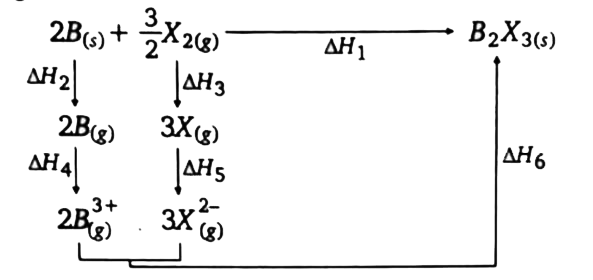The equation ΔH=ΔH1+ΔH2ΔH3
Kirchoff s equation
vant't Hoff isotherm
van 't Hoff isochore
Hess's law
The correct Answer is:D
A/c. to Hess's law.
Topper's Solved these Questions
- Chemical Thermodynamics & EnergeticsBOOK - NIKITA PUBLICATIONCHAPTER - Chemical Thermodynamics & EnergeticsEXERCISE - QUESTION FROM COMPETITIVE EXAM
35 Videos
- CHEMICAL KINETICS BOOK - NIKITA PUBLICATIONCHAPTER - CHEMICAL KINETICS EXERCISE - MCQs
351 Videos
- CHEMISTRY IN EVERYDAY LIFE BOOK - NIKITA PUBLICATIONCHAPTER - CHEMISTRY IN EVERYDAY LIFE EXERCISE - MCQs
224 Videos
Similar Questions
Consider the following process for the conversion of A to D.

How many of the following represent the CORRECT expressions, according to the Hess's law?
i. ΔH1+ΔH2+ΔH3=ΔH4+ΔH5
(ii) ΔH6=ΔH4+ΔH5
(iii) ΔH3=ΔH6−ΔH1−ΔH2
(iv) ΔH2=ΔH6−ΔH4−ΔH5
v. ΔH(6)=ΔH1+ΔH2+ΔH3
(vi) ΔH4=ΔH6+ΔH5
View SolutionNH3(g)+3Cl2(g)→NCl3(g)+3HCl(g), ΔH1
N2(g)+3H2(g)→2NH3(g), ΔH2
H2(g)+Cl2(g)→2HCl(g), ΔH3
The heat of formation of NCl3 in the terms of ΔH1,ΔH2andΔH3 is
View Solution
Knowledge Check
Consider the following Born-Haber's cycle:

(Where ΔH1,ΔH2,ΔH3,ΔH4,ΔH5andΔH6 are in kJ/mol)
Then according to given information the correct statement is/are:AΔH2andΔH3 are always positiveBΔH1=2ΔH2+32ΔH3+2ΔH4+3ΔH5+ΔH6CSecond electron gain enthalpy of X is negativeDΔH1 must be negative for formationn of B2X5(s)NH3(g)+3C12(g)→NCL3(g)+3HC1(g)ΔH1
N2(g)+3H2(g)→2NH3,ΔH2
H2(g)+CL2(g)→2HC1(g),ΔH1
The heat of fomation of NC12(g) in the terms of ΔH1 , ΔH2 and ΔH3 isAΔHf=−ΔH1+ΔH22−32ΔH3BΔHf=ΔH1+ΔH22−32ΔH3CΔHf=ΔH1−ΔH22−32ΔH3DNone of the aboveNH3(g)+3Cl2(g)→NCl3(g)+3HCl(g), ΔH1
N2(g)+3H2(g)→2NH3(g), ΔH2
H2(g)+Cl2(g)→2HCl(g), ΔH3
The heat of formation of NCl3 in the terms of ΔH1,ΔH2andΔH3 isAΔHf=−ΔH1+ΔH22−32ΔH3BΔHf=ΔH1+ΔH22−32ΔH3CΔHf=−ΔH1−ΔH22−32ΔH3DNone
Given
a. NH3(g)+3CI(g)→NCI3(g),3HCI(g),ΔH1
b. N2(g)+3H2(g)→2NH3(g),ΔH2
c. H2(g)+CI2(g)→2HCI(g),ΔH3
Express the enthalpy of formation of NCI3(g)(ΔfHΘ) in terms of ΔH1,ΔH2,and ΔH3.
View SolutionGiven
a. NH3(g)+3CI(g)→NCI3(g),3HCI(g),ΔH1
b. N2(g)+3H2(g)→2NH3(g),ΔH2
c. H2(g)+CI2(g)→2HCI(g),ΔH3
Express the enthalpy of formation of NCI3(g)(ΔfHΘ) in terms of ΔH1,ΔH2,and ΔH3.
View SolutionNH3(g)+3Cl2→NCl3(g)+3HCl(g),ΔH1
N2(g)+3H2(g)→2NH3(g),ΔH2
H2(g)+Cl2(g)→2HCl(g),ΔH3
The heat of formation of NCl3(g) in the terms of
ΔH1,ΔH2,ΔH3 is :
View SolutionGiven,
NH3(g)+3Cl2(g)NCl3(g)+3HCl,−ΔH1
N2(g)+Cl2(g)→2NH3(g),−ΔH2
H2(g)+Cl2(g)→2HClg,−ΔH3
The heat of formation of NCl3(g) in the terms of ΔH1,ΔH2 and ΔH3 is
View SolutionNH3(g)+3Cl2→NCl3(g)+3HCl(g),ΔH1
N2(g)+3H2(g)→2NH3(g),ΔH2
H2(g)+Cl2(g)→2HCl(g),ΔH3
The heat of formation of NCl3(g) in the terms of
ΔH1,ΔH2,ΔH3 is :
View Solution
